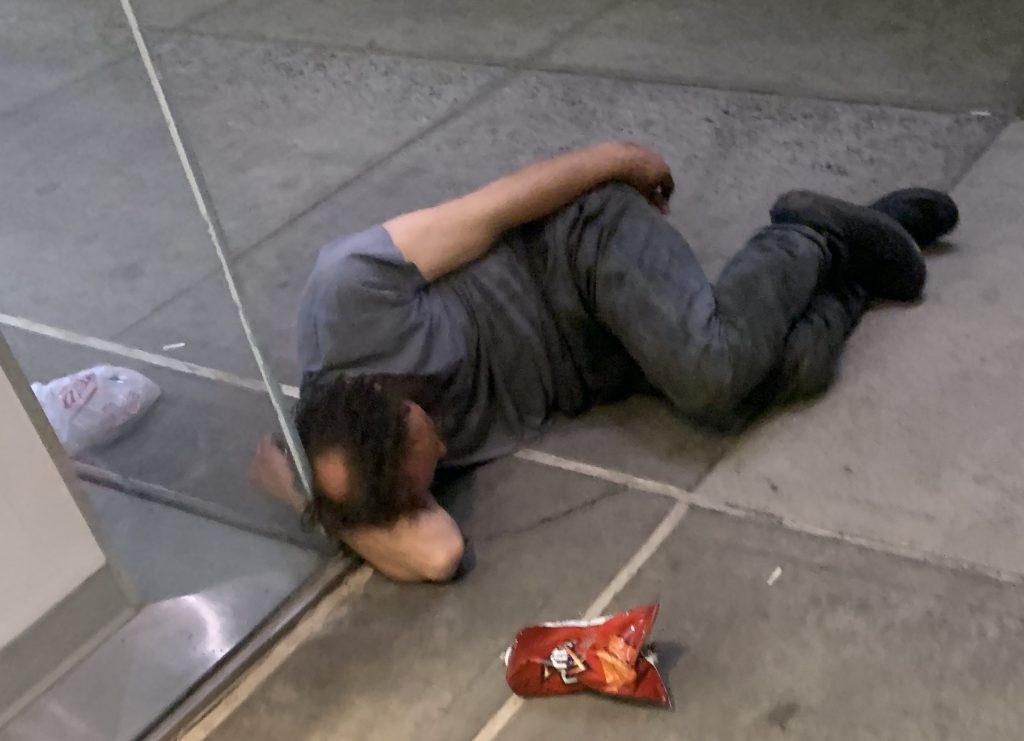
I've spent a lot of time around homeless people. For starters, they were the focus of my senior thesis in high school in Washington, D.C. For a tallboy of malt liquor, many "rough sleepers" freely shared their life stories. From there I proceeded to live in large cities (primarily New York) where stepping around them on the street is the rule, not the exception.
Like many, I've volunteered in a few soup kitchens as part of my church's outreach. Each time, I came away with the sense that many of the volunteers were there to collect a moral gold star, a virtue signaling merit badge in the eyes of their priest. The homeless--vastly more men than women--are reduced to role-players, nodding mute or mumbled thanks in the glare of fluorescent bulbs of a church basement or civic auditorium. Their shame is plain. The entire exercise is a tired affirmation of the do-nothing status quo.
I've witnessed a street duel between two men who used construction site detritus for crude swords and shields, I've had a man jab at me on the subway with a rolled up newspaper. And of course I've seen countless evidence of human defecation, some of it in real time. An elderly woman took up residence on my back stoop for a few months, I had to ask her to move all her earthly possessions in order to take out the garbage.
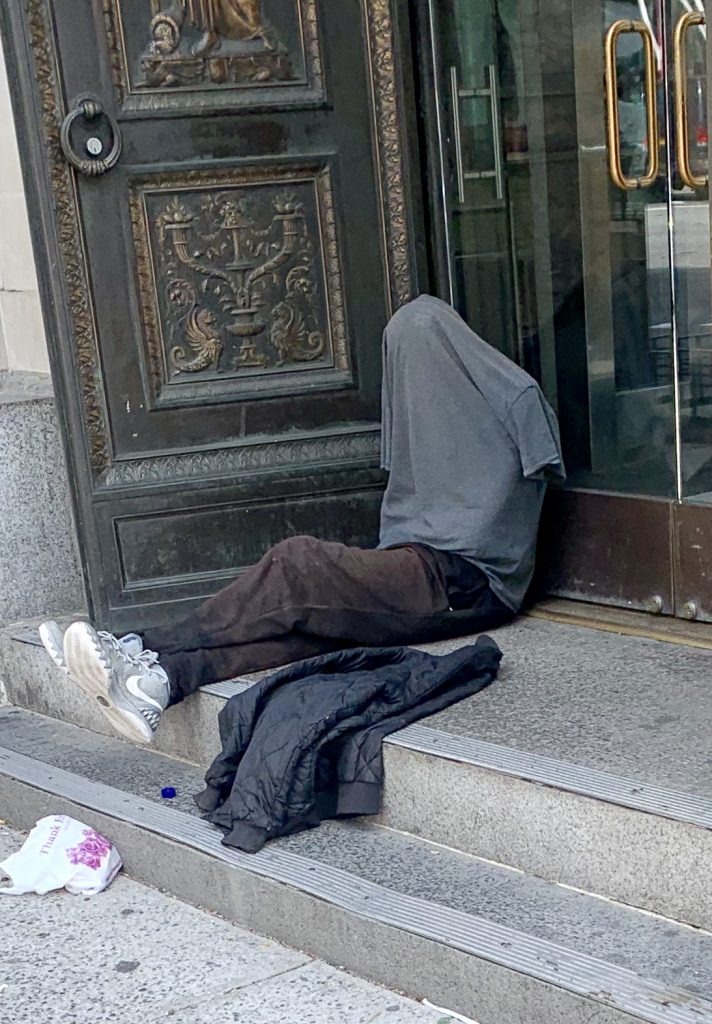
Just last week, I witnessed a black homeless man intentionally knocking unsuspecting elderly white women to the ground. One fell on a subway grate, she looked to be about 75 years old. While a few people yelled at him--Hey, what the hell, man?!--I called the cops and followed the vagrant for several blocks until the cruiser caught up to our location. I'm convinced no one else would have done anything, despite the obvious nature of the "hate crime."
I've also taken photos of local homeless folks for years. Yes, it's a morally fraught hobby. I'm invading their privacy in a way, and some might see it as an attack on their dignity, to make a record of what is a low, even the lowest, time in their lives.
I justify it as documentation. A way to recognize a plight that shouldn't exist, that is within our power to change. I also make donations to my subjects if they are approachable, preferably food or toiletries, in exchange for their (sometimes) involuntary participation. In the rare case that they're selling something legal, I often buy it, such as this book of poems:

We have witnessed many of our once-great cities fall further into ruin due to homeless people blighting public squares and highway underpasses, and once-eradicated diseases such as typhus break out in even the wealthiest pockets of the country.
That's a crucial difference between conservatives and the (new) left: we seek commonsense solutions, whereas they try to gain votes through infantilizing handouts, and worse, to create desired outcomes through the alchemy of social justice.
Yes, those places are progressive cities like San Francisco, Los Angeles, New York and others. Most CD Media readers are well aware that liberal legislation tends to strengthen the dependency bond with their voters, not encourage independence. I'm not writing that article, it has been written countless times before.
I want to talk about common sense solutions we can all ask our elected officials to pursue, and individuals taking action whom you can join or support. That's a crucial difference between conservatives and the (new) left: we seek hard solutions, whereas they try to gain votes through infantilizing handouts, and worse, to create desired outcomes through the alchemy of social justice.
I was thrilled to hear President Trump speak recently about his desire to take on the homeless problem. Along with HUD Secretary Ben Carson, the will to eradicate tent cities and take bold steps is there. What I haven't yet heard is how the administration will deal with the problem in the long run.
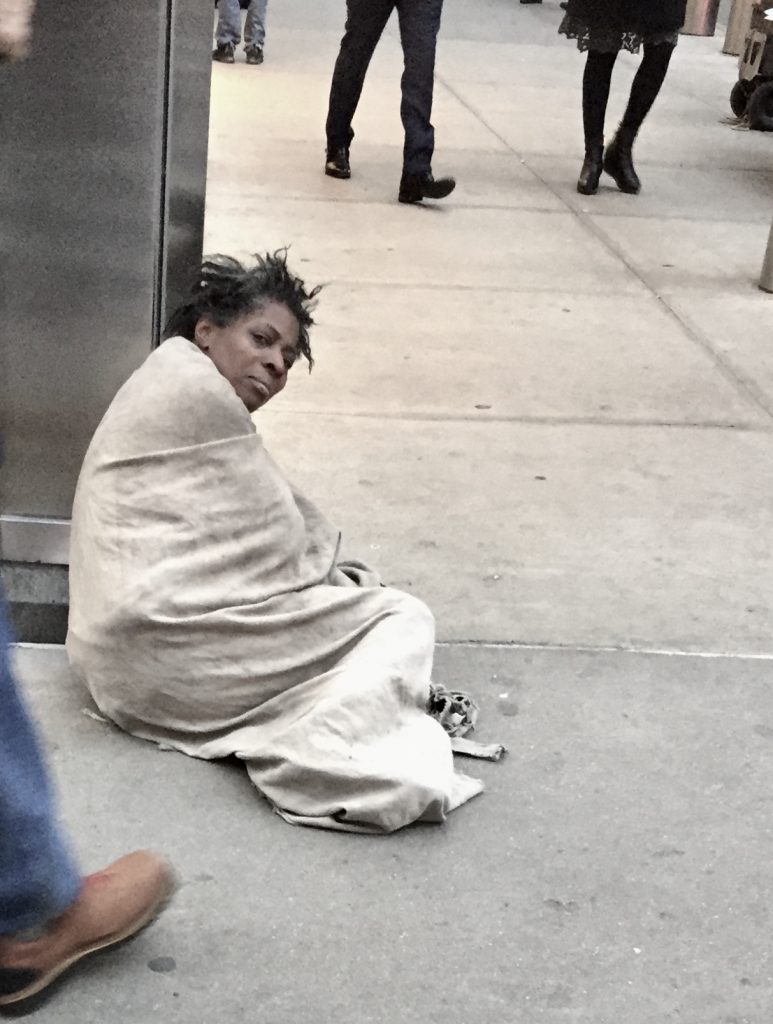
Viewed statistically, homelessness seems entirely surmountable. According to government surveys, in excess of 550,000 Americans were homeless on an average night in 2018, and 1.4 million spent time in a shelter. So there it is: half a million.
That's the crux of the problem--transforming half a million lives.
The problem isn't in the total number, it's the complexity of who constitutes the population. We can do better by our fellow Americans who are enduring hard financial times, addiction, mental illness, combat-related trauma, and runaways with abusive parents, to name the majority of the cohorts. More on this below, but first, why take on this problem?
On a patriotic level, and thinking as a parent, we must clean up our streets and cease to present a picture of America to our children (and ourselves) that it's acceptable to have filthy, often diseased, and mentally unstable people literally sleeping on sidewalks, scraping and begging for money, sometimes threatening taxpaying citizens. No one wants that interaction. Bodies on the roadside like so much litter. It is beneath us to allow such squalor. It--they--must be cleaned up, efficiently and humanely.
It's the:
thing to do. Take your pick.
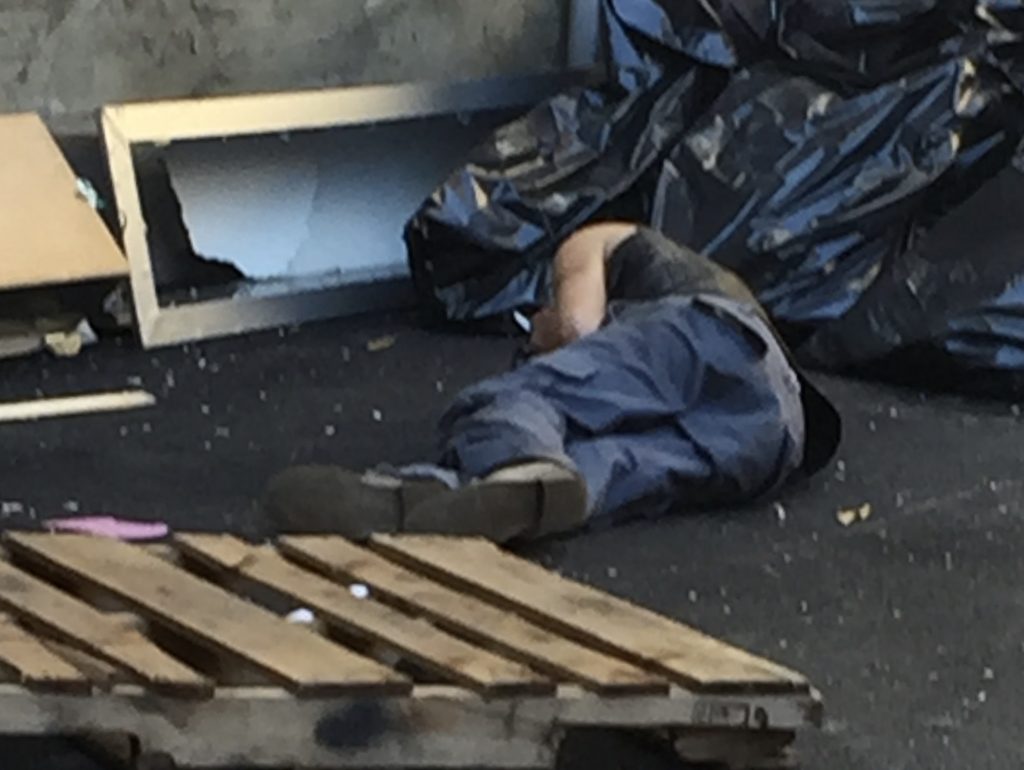
By highest rate of homelessness, liberal enclaves are the leaders in homelessness. No surprise there. In Washington, D.C., 99 in 10,000 are homeless. In New York and Hawaii, 46 in 10,000. Oregon: 35. California, 33.
By total number of homeless, California is king, with New York not far behind: 129,972 and 91,897, respectively. At nearly 222,000, that's nearly half of our nationwide problem in just two states, and it's concentrated in urban areas.
Below are inexpert solutions to a complex problem. Still, they are undeniably necessary steps to take care of the sad, unnecessary blight, the resolvable issue of Americans in the street. Let's begin by dissecting the half-million: from what do they suffer, and how should they be treated?
A Harvard paper citing the National Institute of Mental Health points out the severity of mental illness among the homeless:
Mental illness is also often cited as a major cause of homelessness, illustrating a causative relationship that extends beyond mere correlation. Unsurprisingly, mental illnesses can strain relationships with others, disrupt capabilities of self-care, and interrupt the routine of a daily job, which are all factors that can lead to homelessness. Also, people who are homeless and suffer from mental illness are more prone to problems in physical health due to neglect of self-care, leading to prevalence of respiratory infections, HIV, and substance abuse. Studies show that psychotic homeless individuals have a higher chance of being physically assaulted. A study in Baltimore showed that nearly one-third of homeless women had been raped.
The hardest pill for small-government advocates like me to swallow: we need to spend money on the problem. Deinstitutionalization, or the closure of psychiatric hospitals beginning in the 1950s, has resulted in prisons awash in the mentally unwell, as reported by PBS:
Mental illness affects a significant proportion of the homeless population. A study by the National Institute of Mental Health found that approximately 6% of Americans are severely mentally ill, compared to the 20-25% of the homeless population that suffers from severe mental illness. Furthermore, 45% of the homeless population shows history of mental illness diagnoses.
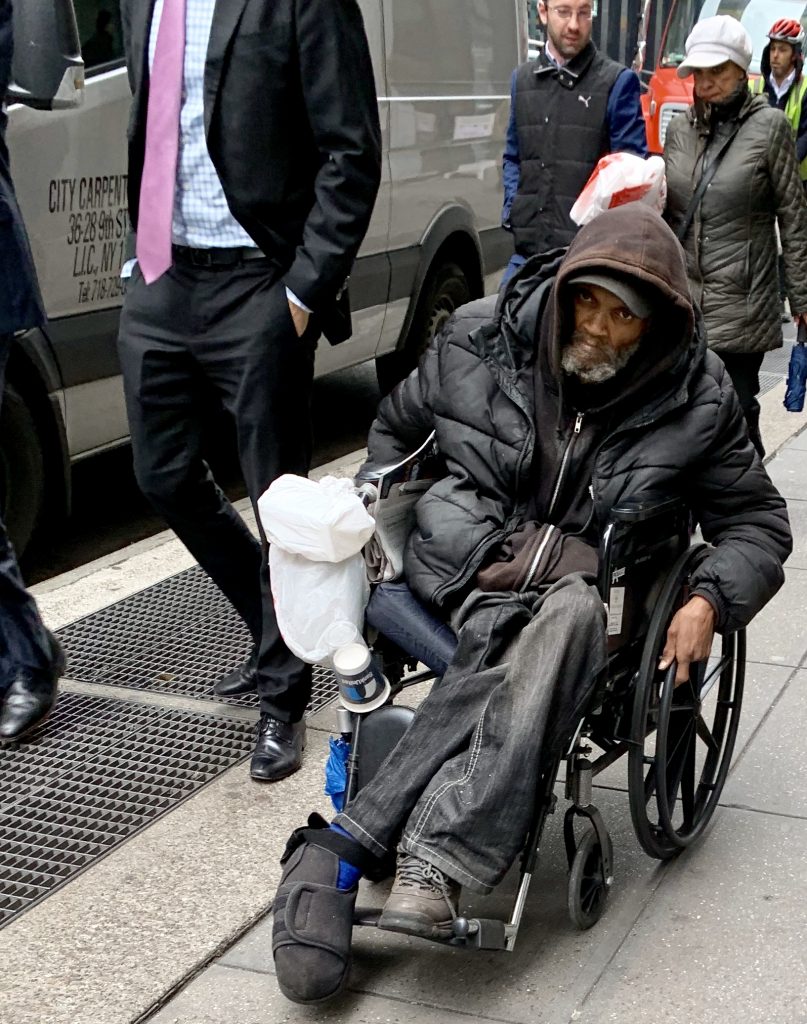
Of the nearly 2 million inmates being held in prisons and jails across the country, experts believe nearly 500,000 are mentally ill. According to the National Alliance for the Mentally Ill (NAMI), 16 percent of the prison population can be classified as severely mentally ill, meaning that they fit the psychiatric classification for illnesses such as schizophrenia, major depression, and bipolar disorder. According to staff at city and community jails, 25 percent of the jail population is severely mentally ill. However, when other mental illnesses, such as anti-social personality disorder, borderline personality disorder and depression, are included, the numbers are much higher, and NAMI puts the number of inmates suffering from both mental illness and substance abuse the percentage at well over 50 percent.
So our first group is the mentally ill, comprising one quarter of the half-million. Meanwhile, another 500,000 mentally ill are in prison, which is not treating the problem and is likely exacerbating it. While in prison, they are more likely to become drug addicts. When released, they are in worse shape than when admitted. That's a poor system.
At the least, segregating such prisoners from general population and treating their illness is better than the status quo. But true change could come if their disorders were treated in asylums.
Nearly half of all Americans are one paycheck away from financial disaster. That's right, a 2018 study puts the number at 44% of Americans who can't absorb a $400 emergency, and only 39% can cover a $1,000 unexpected expense. A significant percentage of the population is living on the edge of financial ruin.
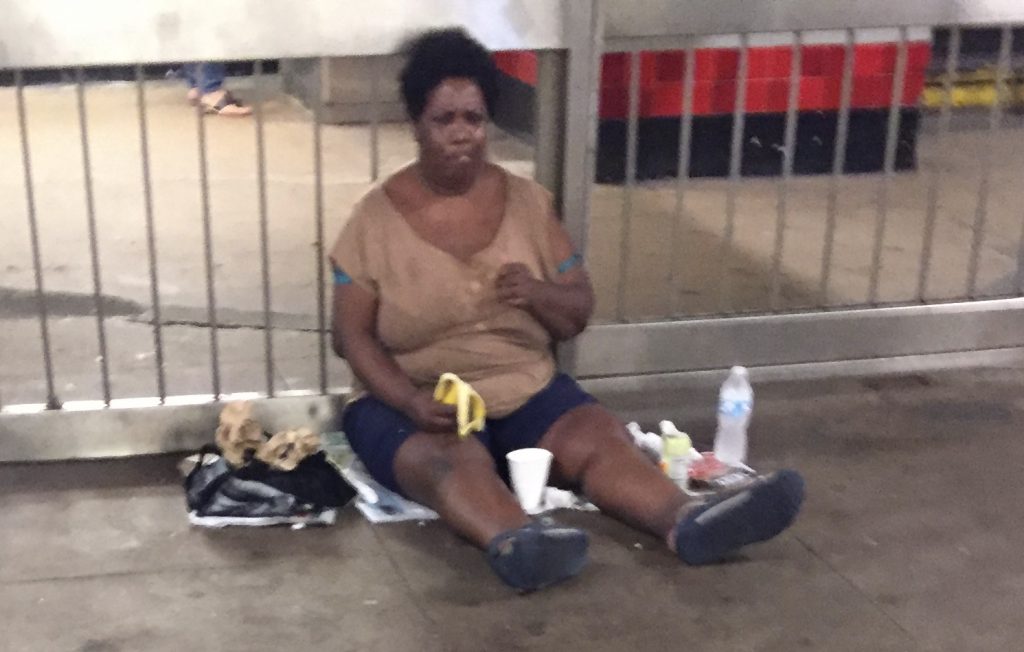
The last thing we need is more welfare. Instead, programs designed to get newly homeless people back in the workforce are vital. The Doe Fund of New York is one such operation. Their motto: "Work works." The nonprofit provides transitional work to recently homeless and substance abusers. I see them on the street every day in their bright blue uniforms. They are, to a person, friendly and fastidious. Most are relegated to trash pickup, but they aren't complaining. They're working.
A nationwide program based on the Doe Fund is one way to address those who aren't mentally unwell, but who have fallen on hard times.

Another segment of the homeless population are our veterans. At roughly 40,000, they aren't anywhere near the largest sector, but given their unique circumstances, they should be a top priority of any national system to eradicate homelessness. The VA hospitals--an area in which Trump has already won plaudits and could likely secure more funding--could be expanded to include a veteran housing unit specifically geared to treat those who suffer from combat-related disorders.
Getting our veterans off the streets demonstrates a meaningful national commitment, not just endless repetitions of "thank you for your service."
To those who wish to act with their hands or their wallets, there are many opportunities. Personally, I disregard the tired bureaucracies that have failed in their charge to dramatically alter the homeless landscape. The National Alliance to End Homelessness is great at producing charts and statistics and defining at-risk groups, but where are the results?
Yes, homelessness is down, albeit slightly. In 2007, the number was 671,000, compared with roughly 550,000 today. It's an improvement, but nothing sweeping, nothing so grand as that which America is capable.
Some inspiring individuals have emerged online, conservatives who want to make America great with their own handsnand minds. If you don't follow Scott Presler on Twitter, do so (#ThePersistence, @ScottPresler). A political activist, Presler and his team cleaned up over 50 tons of garbage from a skid row area in Los Angeles, then again in Baltimore in September and October. His work is not on homelessness itself, but the homeless-adjacent, doing good works among and for impoverished people. Presler is changing attitudes through sheer effort.
Other ways to help? Don't just volunteer to ladle soup. The real work in a homeless shelter is manning the phones, organizing drop-offs and staffing. This list is a good guide to practical ways to help. If you want to support our homeless veterans, here are the top five related charities.
Finally, the best way to support the homeless: vote for conservatives who will fight the welfare-for-votes mentality and put people back to work. Vote for dignity. Spread the word on Trump's homelessness advocacy. Tout the economy that lifts all boats, especially record lows in black and Latino unemployment.
Corrupt mainstream media is certainly not going to do it for you.
Subscribe to our evening newsletter to stay informed during these challenging times!!
[…] Only Conservatives Can End American Homelessness […]
Only Conservatives WANT to end homelessness.
"ard financial times, addiction, mental illness, combat-related trauma, and runaways with abusive parents, to name the majority of the cohorts"
Never a word about self inflicted laziness, indulgence, undisciplined, louts, raised in single family homes, and feeling entitled to free shit. The author and those cited "mental health experts" are simply pushing their own agenda to rob the working, suffering, productive workers.
How you came to those conclusions about the author after reading Anderson’s article is beyond us…but hey, the world needs diverse opinions too…
I agree that there are lazy homeless people.
There was an investigation years ago that followed a few cup-jinglers home.
One can make quite a few bucks pretending to be homeless.
All it costs is your dignity.
But it's not hard to spot a truly homeless person.
The leathery skin, faraway eyes, the crumpled posture, the stench.
That's not laziness--it's abject despair.
Dems don't know how to confront that reality, it's too hard.
We have to step up on homelessness...and continue to cut back on welfare.
Conservatives are always cleaning up after liberals.
Check out this important film on the subject of homelessness: Seattle is Dying: https://komonews.com/news/local/komo-news-special-seattle-is-dying
Seattle is following on San Francisco's heels. San Francisco, too, was once one of the most beautiful and vibrant cities in the world. Today, under decades of Democrat leadership, it is a dying sewer of filth, worse, in many areas, than the slums of Calcutta. Same thing is happening in Seattle under its incompetent leadership.
Seattle spends more than $1 billion dollars per year on the homeless - with absolutely nothing to show for it. Every year it is worse, and I almost can't believe the deterioration over just a few short years.
This is my view. Living on the streets should be illegal and strictly enforced. Seattle should take that annual $1 billion and build appropriate residential facilities for housing and treating all the different types of people who are living on the streets. Drug rehab facilities for the drug addicts. Mental health treatment facilities for the mentally ill. Job training facilities for those who can benefit. These should all be residential, with the aim of helping those who can be helped, but recognizing that many will live there permanently because they will never be competent to live on their own. Those who can be helped could look forward to transitioning back to an independent life. These facilities should be well designed, with good programs and well trained, compassionate staff who can give these people whatever services they can reasonably benefit from. The city should keep using the billions of dollars to build and staff as many of these residential facilities as necessary.
No one should be living on the street, ever. It is against the dignity and health of everyone. The streets should be clean and sparkling and a pleasure for the community to walk on. Neighborhoods should be inviting, clean and welcoming. Every part of the city should be clean and beautiful, even all the currently creepy corners. The same should be true of the residential facilities. Anyone found living on the street should be picked up and moved to one of these residences.
I think this would be far more compassionate for everyone than what is going on now.
This article makes some useful suggestions, but I don't think it makes a strong case for why conservatives would do better. The Supreme Court has not really helped with its recent ruling that prohibits municipalities from arresting people who are sleeping on the street. A couple of years back, there was another story in the news about Seattle. There is an infamous homeless camp there known as "The Jungle." It was the most squalid, dangerous and filthy camp in the city. There were a surprisingly large number of shelter beds nearby that were going unused. These shelters and beds were offered to the camp's residents, and there was not a single taker. Why? The squalor of the camp was the new normal for its residents, just as accepting the squalor was the new normal for the residents of Seattle. And the shelters did not allow drugs and alcohol on the premises, which was unacceptable to the homeless.